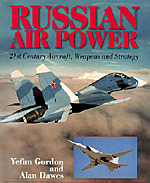 Russian Air Power, by Yefim Gordon and Alan Dawes, Airlife, 2002, 224pp, $39.95
Russian Air Power, by Yefim Gordon and Alan Dawes, Airlife, 2002, 224pp, $39.95
This is a useful, if not excellent book, about the post-Soviet Russian air force. Yefim Gordon is well-qualified to write about the Soviet and Russian air forces. He was an engineer with the Sukhoi design bureau and has written aviation books for thirty years. Mr. Dawes is his translator and specialized in aviation topics. In the book, Mr. Gordon first discusses the reorganization of the Russian Air Force. Caused by the dramatic reduction in funding for all the armed services, all aviation units of the Voyska PVO (air defense forces), Long-Range Aviation, Transport Aviation, and Frontal Aviation are now part of a single unified service, the Voyenno-vozdushnyye Sily (VVS).
In the first chapter, he discusses the organizational history of the Soviet Air Force, then covers the actual consolidation in some detail. In following chapters, he examines each part of the air force in detail, including Frontal Aviation, Long-Range Aviation, Air Defense, Military Transport, paramilitary aviation and training, Naval Aviation, and Army Aviation. Each chapter discusses the missions of the force, its major aircraft types, bases and prospects for modernization. Gordon is frank about the problems facing the VVS, almost all of which are caused by extremely low funding. It affects every aspect of the Air Force, including fuel for training, maintenance parts, new aircraft, pay, even basic repairs to base facilities.
The next chapter deals with Russian air power in action, and for me was the most interesting, because he provides a detailed picture of air combat over Afghanistan and Chechnya. He discusses tactics, the defenses Russian aircraft faced, and not only their successes but their failures. It is well-illustrated with color photos, as are all the chapters.
The final chapter lists the many prototypes and experimental aircraft being developed by the Russian aerospace industry. With anything like sufficient funding, many extraordinary aircraft would be flying and possibly even entering service. These include advanced versions of service types like the MiG-29 and Su-27, the two-seat Su-27IB/Su-34/ Su-32FN, the spectacular S-37 Berkut, and the MiG-I-42/ 44.
While the writing is obviously translated from Russian, it is easy to read. Mr. Gordon is a strong advocate of Russian airpower’s capabilities, and admires the determination of the VVS to function in spite of overwhelming obstacles, as do I. Mr. Gordon provides a clear and complete picture of the VVS as it exists after the collapse of the Soviet Union. Although it is sparse on technical details of the aircraft, they are not part of the book’s purpose, and are well-covered in the series of type-specific books he has written for Aerofax. I would have like to see more details about lower-level organization and training standards, but that is just a personal preference. It’s not a great value, but it’s worth the price.
BT
Back to The Naval Sitrep # 24 Table of Contents
Back to Naval Sitrep List of Issues
Back to MagWeb Master Magazine List
© Copyright 2003 by Larry Bond and Clash of Arms.
This article appears in MagWeb.com (Magazine Web) on the Internet World Wide Web.
Other military history and related articles are available at http://www.magweb.com